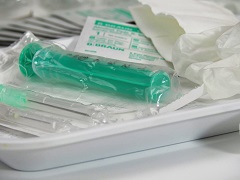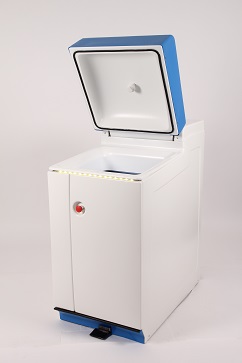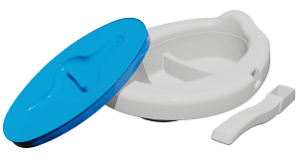Dealing with hospital waste can be a logistical nightmare. But some believe that if medical centres switched to bio-based and biodegradable disposable products, they could simplify their waste management and see other benefits, such as a lower carbon footprint and a reduction in hospital acquired infections.

The problem of hospital waste
Hospitals generate huge amounts of waste. According to the World Health Organization, high-income countries produce up to 0.5 kg of hazardous waste per hospital bed per day, material that may be infectious, toxic or radioactive. But this material only accounts for around 15% of waste produced by healthcare activities, the remaining 85% is comparable to domestic waste. Dealing with all this hospital waste is a complex process and hospitals dispose of it in a number of different ways. Most incinerate their dangerous waste, sending the rest to landfill or to be recycled. Some researchers, however, believe that the waste could be better managed if hospitals switched to biodegradable – mainly bio-based – disposable products. These could then be sent to anaerobic digestion plants or composting facilities, creating a single, more environmentally friendly, waste stream.
‘We have done some studies on what would be interesting products,’ says Christiaan Bolck, program manager for bio-based materials at Wageningen University & Research, in the Netherlands. He explains that there are a few categories of disposable items used in hospitals. Catering supplies, containers used at the bed side (for example, to collect urine and faeces), and single-use equipment useful in operation theatres and similar spaces, such as protective clothing. When they looked at disposable hospital products, Bolck and his colleagues found that many are already biodegradable. ‘Quite a lot of materials used nowadays are already digestible or biodegradable because they are made from cellulose fibres,’ he explains. For these products – which include items like paper cups, tissues and disposable clothing made from cellulose fibres – it is simply a matter of directing them to a waste stream that takes advantage of their biodegradability.
Bio-based substitutes
There are also items that are available in bio-based, biodegradable versions, but often not purchased in these forms. ‘You look at what you can buy right now, that is really the low hanging fruit, you don’t have to develop it you can buy it,’ says Bolck. Many products used for food service fall into this category. Cutlery, plates, dishes and even trays are all available in biodegradable forms that use materials such as bio-based plastics, plant fibres and wood. Cardboard coffee cups, for example, can be difficult to recycle as they often have a non-biodegradable plastic liner. But you can buy them with liners made from PLA (polylactate), a biodegradable plastic produced from biomass such as corn starch or sugar cane.
The most challenging items to make biodegradable are sensitive medical products such as syringes and blood bags. ‘You could make safe versions of many of these from bio-based materials, but for now we are focusing on more generic everyday items that also happen to be used in hospitals,’ adds Bolck. Hospitals use many products, particularly everyday plastic items like packaging, which are not currently biodegradable, but could be produced from biodegradable materials. And there are non-disposable items like steel bed pans that are currently cleaned and reused. These could be replaced with single-use, bioplastic, biodegradable versions.

Biodegradable hospital waste
Biodegradable hospital waste can be sent to a variety of facilities for processing, but one Dutch company has developed an on-site anaerobic digestion system for hospitals. The Pharmafilter system is currently installed at five hospitals in the Netherlands, including Erasmus University Medical Center, the second largest hospital and a leading university medical centre in the country. And other hospitals across Europe are getting ready to or are considering installing the bioreactor. This is designed to take all the hospital waste, including hazardous material like used bandage and syringes, and waste water. And it even takes non-biodegradable rubbish.
The first stage of the system is a high-tech shredder – called Tonto – installed in the hospital wards and other areas that generate waste. ‘The waste on the ward is taken to the shredder – it is no longer stored on the ward – it is treated on site in the sluice room and transported through the sewer pipe,’ explains Peter Kelly, Pharmafilter’s International director. The waste, along with the hospital’s sewer water, goes to the plant and the solid waste is separated from the liquid waste. The liquid waste then enters an advanced treatment plant where filters and bio-reactors remove harmful substances that are a common feature of hospital waste water, such as infectious microorganisms and medicine residues. And the solid waste goes to the anaerobic digestion unit.

Anaerobic digestion
Anaerobic digestion is the breakdown of organic material by microorganisms in the absence of oxygen. The thermophilic digester works at high temperatures of around 70°C. This process produces biogas, which is used to power the installation, with any leftover energy being fed back into grid or used elsewhere in the hospital. ‘When we look at the waste fraction in a hospital and analyse it, a lot of it is cellulose-based, you know food, faeces – there is a lot of energy in that waste,’ says Kelly.
Once the biodigester has finished you are left with the non-biodegradable waste. ‘The non-organic fraction has now been decontaminated by time and temperature so what we end up with is a type of dried fluff and it generally makes its way to a waste to energy plant,’ Kelly explains. According to Kelly, the system has other benefits besides simplifying hospital waste management. It can help tackle antibiotic resistance by reducing the amount of medicine residues entering water treatment plants and lower rates of hospital acquired infections by dealing with rubbish on the wards. ‘If you stop transporting waste throughout the hospital you start reducing hospital acquired infections,’ he concludes.
Content kindly supplied by youris.com.
Interesting? Then also read:
Pharmafilter’s sustainable processing system now commercially available
The role of chemistry in the reduction of plastic waste
New study shows that in Europe, biodegradable plastics growth is in the bag
